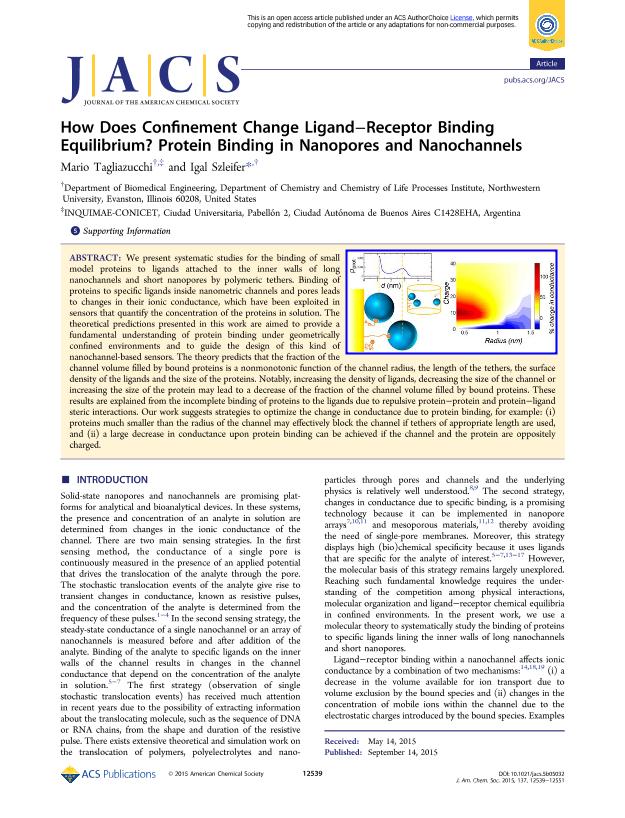Artículo
How does confinement change ligand-receptor binding equilibrium? Protein binding in nanopores and nanochannels
Fecha de publicación:
10/2015
Editorial:
American Chemical Society
Revista:
Journal of the American Chemical Society
ISSN:
0002-7863
Idioma:
Inglés
Tipo de recurso:
Artículo publicado
Clasificación temática:
Resumen
We present systematic studies for the binding of small model proteins to ligands attached to the inner walls of long nanochannels and short nanopores by polymeric tethers. Binding of proteins to specific ligands inside nanometric channels and pores leads to changes in their ionic conductance, which have been exploited in sensors that quantify the concentration of the proteins in solution. The theoretical predictions presented in this work are aimed to provide a fundamental understanding of protein binding under geometrically confined environments and to guide the design of this kind of nanochannel-based sensors. The theory predicts that the fraction of the channel volume filled by bound proteins is a nonmonotonic function of the channel radius, the length of the tethers, the surface density of the ligands and the size of the proteins. Notably, increasing the density of ligands, decreasing the size of the channel or increasing the size of the protein may lead to a decrease of the fraction of the channel volume filled by bound proteins. These results are explained from the incomplete binding of proteins to the ligands due to repulsive protein-protein and protein-ligand steric interactions. Our work suggests strategies to optimize the change in conductance due to protein binding, for example: (i) proteins much smaller than the radius of the channel may effectively block the channel if tethers of appropriate length are used, and (ii) a large decrease in conductance upon protein binding can be achieved if the channel and the protein are oppositely charged.
Palabras clave:
Theory
,
Protein Binding
,
Nanochannel
,
...
Archivos asociados
Licencia
Identificadores
Colecciones
Articulos(INQUIMAE)
Articulos de INST.D/QUIM FIS D/L MATERIALES MEDIOAMB Y ENERGIA
Articulos de INST.D/QUIM FIS D/L MATERIALES MEDIOAMB Y ENERGIA
Citación
Tagliazucchi, Mario Eugenio; Szleifer, Igal; How does confinement change ligand-receptor binding equilibrium? Protein binding in nanopores and nanochannels; American Chemical Society; Journal of the American Chemical Society; 137; 39; 10-2015; 12539-12551
Compartir
Altmétricas




